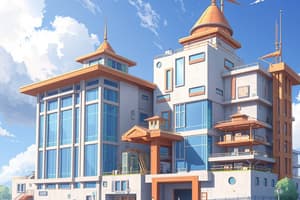Podcast
Questions and Answers
Which building construction type is referred to as noncombustible or protected noncombustible?
Which building construction type is referred to as noncombustible or protected noncombustible?
- Type III
- Type IV
- Type II (correct)
- Type V
Building classifications used in building codes are based on the materials used in construction and the:
Building classifications used in building codes are based on the materials used in construction and the:
- Fire resistance ratings for the structural components (correct)
- Total cost of materials used in its construction
- Size and shape of the structural components
- Estimated amount of time for completion of the building
What does the first digit in the three-digit number code for building classifications represent?
What does the first digit in the three-digit number code for building classifications represent?
- Fire resistance rating (in hours) of interior finishes
- Fire resistance rating (in hours) of exterior bearing walls (correct)
- Fire resistance rating of columns and girders that support loads of more than one floor
- Fire resistance rating of the floor construction
Type I buildings are MOST commonly constructed using a protected steel frame or:
Type I buildings are MOST commonly constructed using a protected steel frame or:
A fundamental fire concern with Type III construction is:
A fundamental fire concern with Type III construction is:
Type IV construction is:
Type IV construction is:
Modern heavy-timber wood frame construction is primarily used:
Modern heavy-timber wood frame construction is primarily used:
In modern construction, Type V light-frame construction:
In modern construction, Type V light-frame construction:
Occupancy classifications reflect the ____ inherent to specific types of occupancies.
Occupancy classifications reflect the ____ inherent to specific types of occupancies.
Which of the following describes the maximum amount of heat that can be released if all fuel is consumed?
Which of the following describes the maximum amount of heat that can be released if all fuel is consumed?
Since spiral stairs can be difficult to traverse, they are generally allowed as part of the means of egress only within:
Since spiral stairs can be difficult to traverse, they are generally allowed as part of the means of egress only within:
Springs in folding stairs lose tension rapidly when exposed to heat, which may cause the stair assembly to:
Springs in folding stairs lose tension rapidly when exposed to heat, which may cause the stair assembly to:
Why are protected stairs extremely important in the overall life safety of a building?
Why are protected stairs extremely important in the overall life safety of a building?
Which of the following BEST describes a major feature of exterior stairs?
Which of the following BEST describes a major feature of exterior stairs?
Flashcards are hidden until you start studying
Study Notes
Building Classifications and Systems
-
Type II Construction: Referred to as noncombustible or protected noncombustible.
-
Building Classifications: Based on fire resistance ratings of structural components, not on cost or building shape.
-
Three-Digit Code: First digit signifies the fire resistance rating (in hours) of exterior bearing walls.
-
Type I Buildings: Commonly feature reinforced concrete or a protected steel frame.
-
Type III Construction Concerns: Principal issue is the creation of combustible concealed spaces.
-
Type IV Construction: Uses wood components with greater mass than Type III; not termed "ordinary construction."
-
Modern Heavy-Timber Wood Frame: Primarily utilized for aesthetic purposes in designs.
-
Type V Light-Frame Construction: Employs smaller studs, joists, and rafters for faster building processes.
-
Occupancy Classifications: Reflect inherent life safety issues pertinent to specific occupancies.
-
Fire Load: Defined as the maximum heat that can be released upon complete consumption of all fuel.
-
Spiral Stairs: Generally permitted as egress components exclusively in residences due to difficulty in traversal.
-
Folding Stairs: Spring tension loss under heat can lead the stairs to swing down into the structure amidst a fire.
-
Protected Stairs: Essential for life safety; they withstand combustion products, facilitating safe egress during emergencies.
-
Exterior Stairs: Characterized by natural ventilation; they do not fully protect against combustion products inside buildings.
-
Fire Escape Anchor Points: Critical for ensuring escape routes are secure during emergencies.
Studying That Suits You
Use AI to generate personalized quizzes and flashcards to suit your learning preferences.




